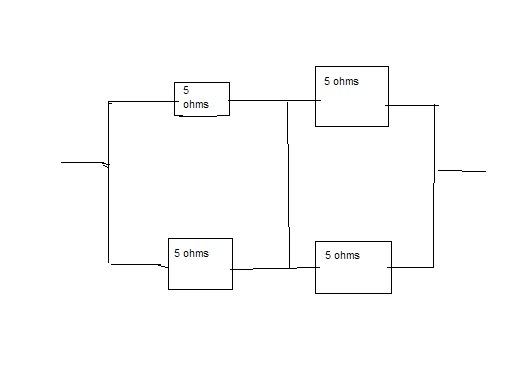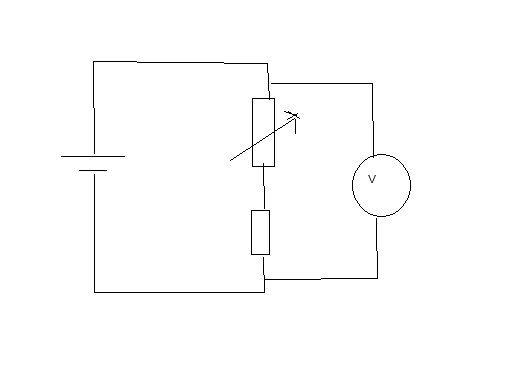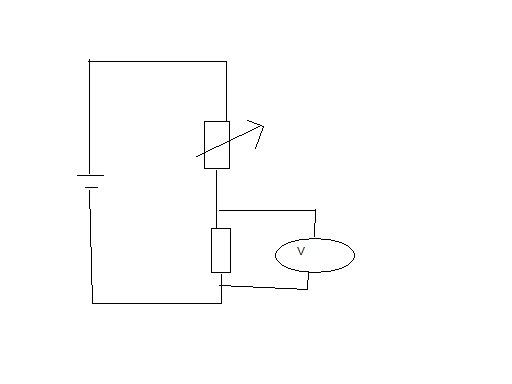Calculating Resistance(Need Help)
-
Hi. I do not know how to calculate resistance for the circuit below. What does the line in the middle of the rectangle mean?

-



If resistance of variable resistor is slowly increased, what woud happen to reading in voltmeter of circuits? I have my answers, just wanna tally. No explanation is needed because I just want to compare if my answers are right and if yes, I should be able to explain them myself. Unless, they are wrong, I'll perhaps seek the help of you guys.
thanks.
-
Originally posted by anpanman:
Hi. I do not know how to calculate resistance for the circuit below. What does the line in the middle of the rectangle mean?

Let do the left side first
1/Rt = 1/R1+1/R2
1/Rt= 1/5 + 1/5
1/Rt = 2/5
Rt =2.5 ohm (left parallel)
similarly if you repeat the right side as above you get another 2.5 ohm (right parallel)
as the centre is joined, it become common therefore RT = Rt(left) + Rt(right)
RT = 2.5 + 2.5
= 5ohm
-
Originally posted by anpanman:



If resistance of variable resistor is slowly increased, what woud happen to reading in voltmeter of circuits? I have my answers, just wanna tally. No explanation is needed because I just want to compare if my answers are right and if yes, I should be able to explain them myself. Unless, they are wrong, I'll perhaps seek the help of you guys.
thanks.
top pic, voltmeter no change (equal to battery voltage)bottom pic, voltmeter will change according to variable resistor change
-
For the top pic,my take is that the voltmeter reading will decrease. This is because as the rheostat resistance increases, current flowing through circuit deceases. which means that the voltage over at the rheostat component remains relatively the same since if R changes, Current will change too.(if R increases, I decreases, and vice versa. So V should be the same) Looking over at the fixed resistor we know that the resistance is the same at the time and will not change regardless of resistance of rheostat, BUT the resistance of rheostat WILL affect current flowing through since this is a SERIES circuit. So my take is that the current decreases but fixed resistor has same resistance. This will decrease the voltage. And hence voltage of circuit decreases.
Sounds complicated but I do think my reasoning seems logical. Please correct me if I am wrong because I kind of don't agree that the voltmeter records no change.
-
For the top pic,my take is that the voltmeter reading will decrease.
wrong.
total e.m.f. of circuit = total p.d. of the components of the circuit
This is because as the rheostat resistance increases, current flowing through circuit deceases. which means that the voltage over at the rheostat component remains relatively the same since if R changes, Current will change too.(if R increases, I decreases, and vice versa. So V should be the same) Looking over at the fixed resistor we know that the resistance is the same at the time and will not change regardless of resistance of rheostat, BUT the resistance of rheostat WILL affect current flowing through since this is a SERIES circuit. So my take is that the current decreases but fixed resistor has same resistance. This will decrease the voltage. And hence voltage of circuit decreases.
If rheostat increases in resistance, the voltage across it will increase accordingly. And since you kept blabbering abt SERIES CIRCUIT yet NEVER realised that current is constant throughout a series circuit (physics law)
Now this is settled, let's look at the other ones.
2nd pic, V decreases.
3rd pic, V increases.
Any further queries?
-
Originally posted by anpanman:
For the top pic,my take is that the voltmeter reading will decrease. This is because as the rheostat resistance increases, current flowing through circuit deceases. which means that the voltage over at the rheostat component remains relatively the same since if R changes, Current will change too.(if R increases, I decreases, and vice versa. So V should be the same) Looking over at the fixed resistor we know that the resistance is the same at the time and will not change regardless of resistance of rheostat, BUT the resistance of rheostat WILL affect current flowing through since this is a SERIES circuit. So my take is that the current decreases but fixed resistor has same resistance. This will decrease the voltage. And hence voltage of circuit decreases.
Sounds complicated but I do think my reasoning seems logical. Please correct me if I am wrong because I kind of don't agree that the voltmeter records no change.
V = IR
if V is constant, Current will increase when R decrease and vis-versa. for the the first pic, V is for the whole circuit.
for the 3rd pic, voltmeter is only measuring the 2nd resistor only
-
Originally posted by Garrick_3658:
wrong.
total e.m.f. of circuit = total p.d. of the components of the circuit
If rheostat increases in resistance, the voltage across it will increase accordingly. And since you kept blabbering abt SERIES CIRCUIT yet NEVER realised that current is constant throughout a series circuit (physics law)
Now this is settled, let's look at the other ones.
2nd pic, V decreases.
3rd pic, V increases.
Any further queries?
2nd pic , V is constant -
Originally posted by anpanman:



If resistance of variable resistor is slowly increased, what woud happen to reading in voltmeter of circuits? I have my answers, just wanna tally. No explanation is needed because I just want to compare if my answers are right and if yes, I should be able to explain them myself. Unless, they are wrong, I'll perhaps seek the help of you guys.
thanks.
pic top = voltmeter constantpic middle = voltmeter varies with variable resistor
pic bottom = voltmeter vries with variable resistor.
i thought i only see 2 pic
-
Originally posted by SevenEleven:
2nd pic , V is constantWhen R of rheostat increases, V increases accordingly. Since e.m.f. = total p.d., therefore, V of resistor decreases when V of rheostat increases.
-
Originally posted by SevenEleven:
Let do the left side first
1/Rt = 1/R1+1/R2
1/Rt= 1/5 + 1/5
1/Rt = 2/5
Rt =2.5 ohm (left parallel)
similarly if you repeat the right side as above you get another 2.5 ohm (right parallel)
as the centre is joined, it become common therefore RT = Rt(left) + Rt(right)
RT = 2.5 + 2.5
= 5ohm
Can straightaway take away the wire at the centre because there's no potential difference across the wire; no current flowing through.
-
Originally posted by anpanman:
For the top pic,my take is that the voltmeter reading will decrease. This is because as the rheostat resistance increases, current flowing through circuit deceases. which means that the voltage over at the rheostat component remains relatively the same since if R changes, Current will change too.(if R increases, I decreases, and vice versa. So V should be the same) Looking over at the fixed resistor we know that the resistance is the same at the time and will not change regardless of resistance of rheostat, BUT the resistance of rheostat WILL affect current flowing through since this is a SERIES circuit. So my take is that the current decreases but fixed resistor has same resistance. This will decrease the voltage. And hence voltage of circuit decreases.
Sounds complicated but I do think my reasoning seems logical. Please correct me if I am wrong because I kind of don't agree that the voltmeter records no change.
The voltage of the circuit remains the same, because it is supplied by the battery.
The current in the circuit will actually decrease as R increase. But V = IR remains constant.